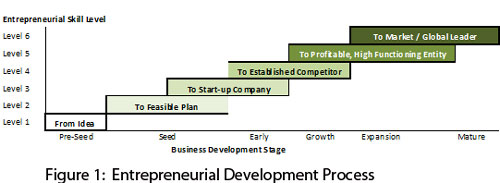 Although every business and entrepreneur is unique, there are common evolutionary stages that businesses need to undergo to maximize commercial potential and sustain growth. Many entrepreneurial businesses fail or stagnate because of poor planning and because the entrepreneur does not realize what needs to be done next. An entrepreneur needs to continuously improve his/her skills to allow the company to proceed to the next level (See Figure 1). Moving from the Early Stage through the Growth Stage is often one of the most difficult for entrepreneurs.
Although every business and entrepreneur is unique, there are common evolutionary stages that businesses need to undergo to maximize commercial potential and sustain growth. Many entrepreneurial businesses fail or stagnate because of poor planning and because the entrepreneur does not realize what needs to be done next. An entrepreneur needs to continuously improve his/her skills to allow the company to proceed to the next level (See Figure 1). Moving from the Early Stage through the Growth Stage is often one of the most difficult for entrepreneurs.
Key developmental milestones
The Growth Stage is defined by a rapid expansion of sales as the company learns from and builds upon earlier customer traction. Growth can occur through introduction of new products/services, expanding geographic reach, acquisition of competitors or attracting new target customers. Growth may allow smaller, locally based companies to become competitors on a provincial, national or international scale by establishing competitive barriers, such as patents, trademarks, brands, market saturation, production efficiencies, cost advantages, exclusive relationships with channel partners and/or technological superiority. Rapid growth is often accompanied by growing pains. Growing revenue is important, but the cost of fueling these additional revenues must be kept in balance. New formal policies, procedures and reporting systems need to be established and fully implemented before entering the Growth Stage. When used appropriately, these tools allow entrepreneurs to objectively view the status and progress of the company and identify and respond to issues before they become critical. They are also critical to maintaining work-life balance as the business becomes increasingly complex. The entrepreneur needs to maintain a focus on the corporate break-even point, where the business has generated as much cash as has been consumed to date. In the case that the entrepreneur doesn’t reach that point or becomes marginally profitable (and is not burdened by paying back any of the cash consumed to date to investors), he/she may have created a “lifestyle” company and an ongoing job for himself/herself and a few employees. There is nothing wrong with that, but opportunities to invest in additional growth or to raise external investment will be limited, if not impossible, until the entrepreneur demonstrates the desire and ability to grow beyond this initial “comfortable” plateau.
It is important to note that true growth is more than just hiring more staff and increasing operational capability to produce a linear increase in revenue. It is the prolonged period of increasing profitability based on economies of scale that defines the Growth Stage. Consequently, increasing staff from two employees to four employees to double revenues does not necessarily indicate that a company has entered the Growth Stage, but increasing from 10 to 20 employees to produce 10 times the revenue may. Because of the challenges posed by growth, statistics show that most new firms fail within the first five years of existence and very few companies grow to any significant size. Poor planning, execution and management skills of new entrepreneurs are primary factors behind failures.
What are the Barriers to Growth?
Failure to Delegate The new skills and ways of thinking that are required at the Growth Stage fundamentally changes to the role of original entrepreneur. The desire to control and lead all aspects of the business becomes impossible when the company reaches a certain scale (e.g. 10 to 15 staff). Learning how to delegate responsibility is essential. Failure to do so will leave staff unmotivated, increase the probability that important issues will be over-looked and lead to exceptionally long work hours. It is important for participants to understand that complexity can be managed and that work-life balance can be maintained through adoption of new management systems and processes. (Details on how to do this will be provided in a future blog post). As part of the shift from an informal entrepreneur-centric mindset to a formal, efficient team mindset, the role of the initial entrepreneur(s) needs to change. The desire to control and lead all aspects of the business becomes impossible when the company reaches a certain scale (e.g. 10 to 15 staff). Learning how to delegate responsibility is essential. Failure to do so will leave staff unmotivated, increase the probability that important issues will be over-looked and lead to exceptionally long work hours.
Finding the Courage to Meet the Needs of New Customers Geoffrey Moore’s “Crossing the Chasm” has become a roadmap for building high technology companies. However, its theories are largely applicable to any company that wishes to grow. Customers that are attracted at the Early Stage often have a different profile than those you will need to attract to grow. Early customers may include friends and family, a local market that is underserved, or people who always like to try something new (e.g. need the latest fashions, need to be the first one to eat at a new restaurant, or need to be the first one to show off a new product to their friends). These customers represent a small number of all potential customers. To attract the majority of customers for your product/service, you need to change your approach and create a different value proposition—particularly if you are expanding away from a local market and into one with more competitors. Failure of companies to change their approach often leads to failure, or dropping into Moore’s “chasm.” The early majority are skeptics who need to know that they are buying the best of several alternatives. Winning them over is hard, but if you do, they will become avid supporters and become an excellent reference group to win over the even more conservative “laggards” or late majority. Demonstrating the superiority of your product/service requires much planning and preparation. Many entrepreneurs find this process too intimidating and try to stick with the more friendly early market. However, since the early market always likes the latest and best things, they will move on if you don’t satisfy them with new products/services. There is risk in trying to get over the chasm, but there is also great risk in playing it safe. Many of the start-ups that fail do so because they don’t know how to grow and the early stage target market is too small to provide sustainable cash flow.
The Need for External Financing To meet the demands of a growing customer base, additional infrastructure and staff are often required. Often these costs need to be incurred before increased revenues are earned. Whereas earlier stages of development are often funded with personal assets or contributions from family and friends, the significant capital needed for growth may have to be sought from truly external sources for the first time. There are numerous sources of capital, and each funds different activities. It is important to understand the differences between personal and business loans from a bank or financial institution, and also if a strategic partner is more preferable. Entrepreneurs need to develop financial literacy at this stage to make better decisions and to communicate effectively with investors.
Part 2: Tips on how to plan for growth Part 3: Financing Growth
This blog is extracted from materials co-developed by David Gauthier and the Manitoba Women’s Enterprise Centre for their “My Gold Mine” project, and based on concepts originally developed by the Entrepreneurial Foundation of Saskatchewan.
Dr. David Gauthier is president and CEO of Genome Prairie
Photos courtesy of Genome Prairie
